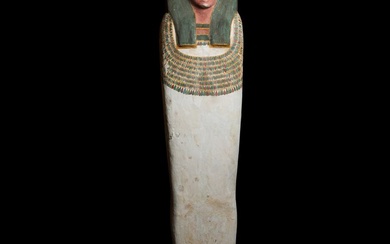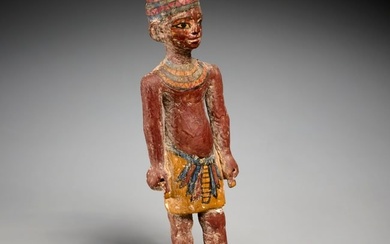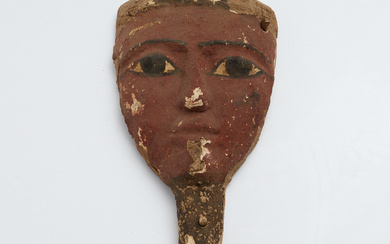Egyptian Late Period Painted Wood Falcon Sarcophagus
Egypt, Late Dynastic Period, 26th to 31st Dynasty, ca. 664 to 332 BCE. A rare, hand-carved wood (likely cedar) lidded mummiform sarcophagus depicting a falcon-headed figure, perhaps representing Horus, the god of the sky, and bestowing kingship. The lid presents a wonderful falcon head composed of a short beak, smooth cheeks, human-like ears, and a furrowed brow, with hemispherical eyes, apropos as the falcon deity's right was interpreted as the sun or morning star - representing mighty power - and his left eye as the moon or evening star - representing the ability to heal. The hollow lid has six tenons that fit within six corresponding mortises on the lower half. Thick swaths of original, age-darkened pigment decorate both halves of the sarcophagus, and traces of vivid yellow pigment comprise facial details, a wesekh-collar, a depiction of the winged Isis, a hieroglyphic inscription on the back column, and at least one of the Sons of Horus, perhaps the falcon-headed Qebesenuef. Size: 7.875" W x 20.9" H (20 cm x 53.1 cm)
The ancient Egyptians believed that their pharaoh was a personification of Horus the sky god - depicted as either a falcon-headed man donning the pschent (a red and white crown) to symbolize his reign over Egypt or as the bird itself - a powerful icon of power, speed, and talent for hunting - as we see in this example. Certainly this association between Horus and the king existed from the early Dynastic period (ca. 3100 BCE); however, the Horus king cult became very popular during the Ptolemaic Period. What's more statues of Horus were created to adorn temples as an image of kingship - capturing an image of Horus on earth.
Interestingly, cedar wood was not native to Egypt. Egypt did not have verdant forests filled with tall trees, and unfortunately most of its native lumber was of relatively poor quality. Thus, they relief on importing to acquire hardwoods - ebony imported from Africa, cedar and pine from Lebanon. One fabulous obelisk inscription by Thutmose III attests to the luxury of hardwoods. It reads as follows, "They brought to me the choicest products...consisting of cedar, juniper and of meru wood...all the good sweet woods of God's Land." The rarity of cedar meant that a sarcophagus like this example were reserved for those who could afford them.
Provenance: private J.H. collection, Beaverton, Oregon, USA
All items legal to buy/sell under U.S. Statute covering cultural patrimony Code 2600, CHAPTER 14, and are guaranteed to be as described or your money back.
A Certificate of Authenticity will accompany all winning bids.
We ship worldwide to most countries and handle all shipping in-house for your convenience.
#149652
Condition Report: Chips and abrasions to areas of base, joint lines, tenons, mortises, and head, with darkening to original pigment commensurate with age, softening to some finer details, and several stable hairline fissures that are not detrimental to the item's structural integrity. Wonderful traces of original pigment throughout.
View it on
Sale price
Estimate
Time, Location
Auction House
Egypt, Late Dynastic Period, 26th to 31st Dynasty, ca. 664 to 332 BCE. A rare, hand-carved wood (likely cedar) lidded mummiform sarcophagus depicting a falcon-headed figure, perhaps representing Horus, the god of the sky, and bestowing kingship. The lid presents a wonderful falcon head composed of a short beak, smooth cheeks, human-like ears, and a furrowed brow, with hemispherical eyes, apropos as the falcon deity's right was interpreted as the sun or morning star - representing mighty power - and his left eye as the moon or evening star - representing the ability to heal. The hollow lid has six tenons that fit within six corresponding mortises on the lower half. Thick swaths of original, age-darkened pigment decorate both halves of the sarcophagus, and traces of vivid yellow pigment comprise facial details, a wesekh-collar, a depiction of the winged Isis, a hieroglyphic inscription on the back column, and at least one of the Sons of Horus, perhaps the falcon-headed Qebesenuef. Size: 7.875" W x 20.9" H (20 cm x 53.1 cm)
The ancient Egyptians believed that their pharaoh was a personification of Horus the sky god - depicted as either a falcon-headed man donning the pschent (a red and white crown) to symbolize his reign over Egypt or as the bird itself - a powerful icon of power, speed, and talent for hunting - as we see in this example. Certainly this association between Horus and the king existed from the early Dynastic period (ca. 3100 BCE); however, the Horus king cult became very popular during the Ptolemaic Period. What's more statues of Horus were created to adorn temples as an image of kingship - capturing an image of Horus on earth.
Interestingly, cedar wood was not native to Egypt. Egypt did not have verdant forests filled with tall trees, and unfortunately most of its native lumber was of relatively poor quality. Thus, they relief on importing to acquire hardwoods - ebony imported from Africa, cedar and pine from Lebanon. One fabulous obelisk inscription by Thutmose III attests to the luxury of hardwoods. It reads as follows, "They brought to me the choicest products...consisting of cedar, juniper and of meru wood...all the good sweet woods of God's Land." The rarity of cedar meant that a sarcophagus like this example were reserved for those who could afford them.
Provenance: private J.H. collection, Beaverton, Oregon, USA
All items legal to buy/sell under U.S. Statute covering cultural patrimony Code 2600, CHAPTER 14, and are guaranteed to be as described or your money back.
A Certificate of Authenticity will accompany all winning bids.
We ship worldwide to most countries and handle all shipping in-house for your convenience.
#149652
Condition Report: Chips and abrasions to areas of base, joint lines, tenons, mortises, and head, with darkening to original pigment commensurate with age, softening to some finer details, and several stable hairline fissures that are not detrimental to the item's structural integrity. Wonderful traces of original pigment throughout.







